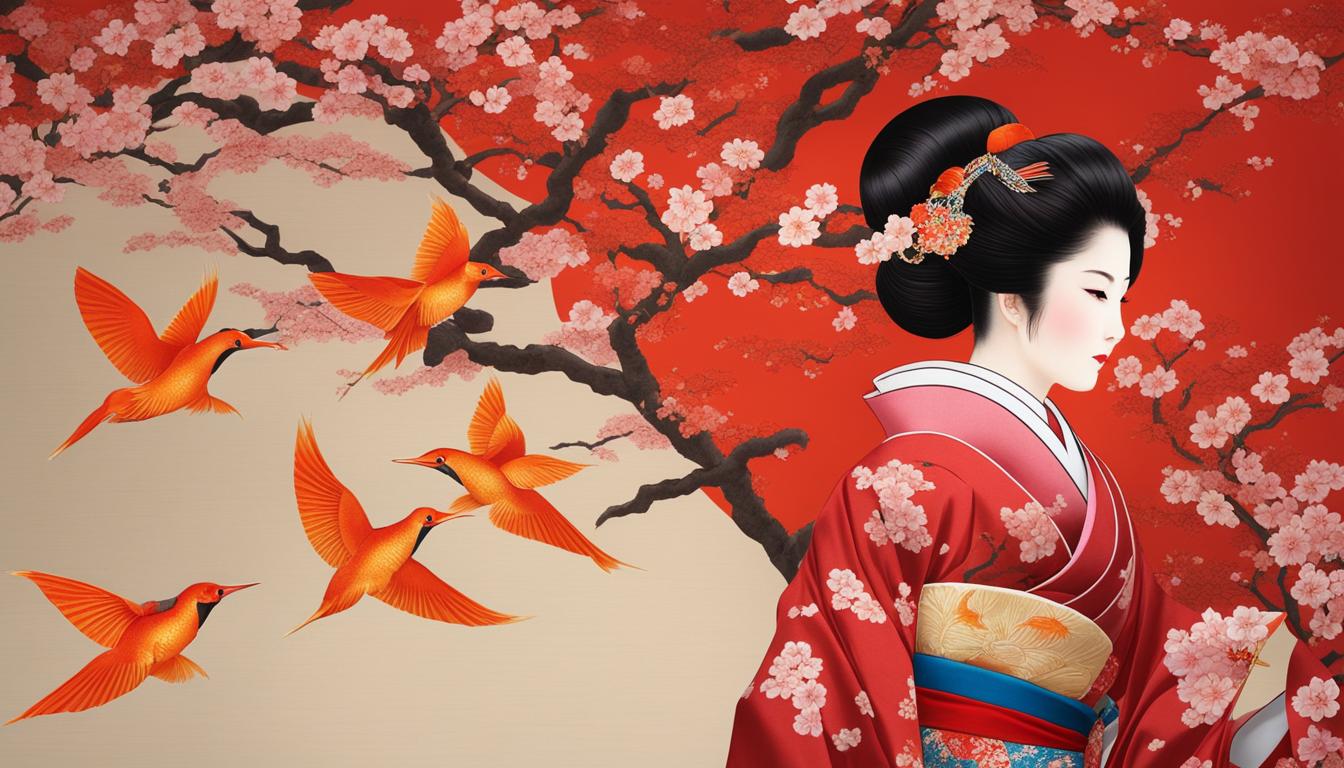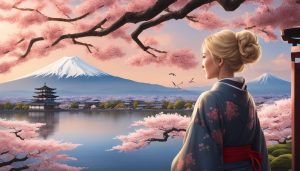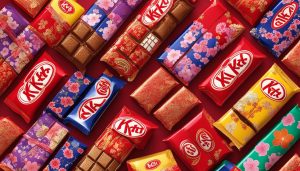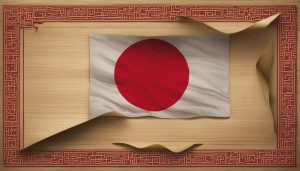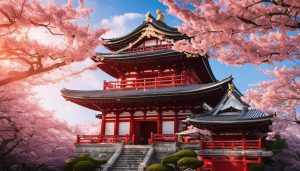Kimonos, with their rich history and intricate designs, hold a deep cultural significance in Japan. These traditional garments are not just beautiful pieces of clothing – they are woven with symbols of good luck that embody Japanese beliefs and traditions. Let’s explore the fascinating world of kimono symbolism and uncover the meaning behind the patterns and motifs that make them truly special.
Contents
- 1 Floral Motifs Symbolizing Good Luck in Kimonos
- 2 Patterns with Symbolic Meaning in Kimonos
- 3 Lucky Symbols in Kimonos and their Cultural Significance
- 4 Lucky Charm Patterns in Kimonos
- 5 Conclusion
- 6 FAQ
- 6.1 What are the symbols of good luck in a kimono?
- 6.2 What do floral motifs symbolize in a kimono?
- 6.3 What do patterns represent in a kimono?
- 6.4 What are some other lucky symbols found in a kimono?
- 6.5 What are “lucky charm” patterns in a kimono?
- 6.6 What is the significance of these symbols in a kimono?
- 7 Source Links
Key Takeaways:
- Symbols of good luck are incorporated into the making of a kimono.
- Floral motifs such as cherry blossoms and irises symbolize new beginnings and good fortune.
- Patterns like the Seigaiha and Shippo represent the ebb and flow of life and Buddhist teachings.
- Other lucky symbols in kimono designs include peacocks, cranes, drums, scrolls, mountains, and rivers.
- “Lucky charm” patterns like Jigami and Ougi-nagashi are believed to bring good luck and positive energy.
Floral Motifs Symbolizing Good Luck in Kimonos
When it comes to kimono symbolism, floral motifs play a significant role in representing good luck and auspiciousness. Japanese flowers are known for their beauty and deep cultural significance, and many of them are incorporated into kimono designs to convey positive meanings.
One such flower is the bellflower, known as Kikyo in Japanese. This elegant flower symbolizes unchanging love and honesty, making it a popular choice for kimonos. Another well-known flower is the cherry blossom, called Sakura in Japanese. These delicate blossoms represent new beginnings and the transient nature of life, adding a touch of optimism to kimono designs.
The iris, peony, and plum blossom are also commonly used in kimono designs to bring good fortune and longevity. The iris, known as Kakitsubata, is associated with protection from evil spirits. The peony, or Botan, symbolizes wealth, honor, and prosperity. The plum blossom, called Ume, represents endurance and resilience.
| Flower | Symbolic Meaning |
|---|---|
| Bellflower (Kikyo) | Unchanging love and honesty |
| Cherry Blossom (Sakura) | New beginnings and the transient nature of life |
| Iris (Kakitsubata) | Protection from evil spirits |
| Peony (Botan) | Wealth, honor, and prosperity |
| Plum Blossom (Ume) | Endurance and resilience |
These floral motifs not only add beauty to kimonos but also carry deep cultural meanings. Wearing a kimono adorned with these symbols of good luck is believed to bring positive energy and blessings to the wearer.
Patterns with Symbolic Meaning in Kimonos
When it comes to the world of kimono design, patterns play a crucial role in conveying deep symbolic meanings. Each pattern holds significance and tells a story within the fabric of these traditional garments. Let’s explore some of the most common patterns found in kimonos and their symbolic associations.
Seigaiha Pattern
The Seigaiha pattern, often referred to as the “wave crest” or “blue ocean wave,” consists of overlapping circles or arches. This pattern represents the ebb and flow of life, symbolizing the continuous cycle of existence and our interconnectedness with the world around us. It serves as a reminder to embrace change and find balance amidst life’s unpredictable tides.
Shippo Pattern
The Shippo pattern, also known as the “seven treasures,” is characterized by diamond shapes arranged in a grid-like formation. Each diamond represents one of the seven treasures from Buddhist teachings, which include gold, silver, lapis lazuli, seashells, agate, crystal, and coral. This pattern symbolizes wealth, prosperity, and spiritual abundance, reflecting the desire for a life filled with blessings and material well-being.
Hexagonal Patterns
Hexagons are a common motif in kimono design and are associated with longevity and good fortune. The six-sided shape represents balance and harmony, as well as the idea of a complete and fulfilled life. The hexagonal pattern is often incorporated into kimono fabrics to invoke blessings of health, happiness, and longevity for the wearer.
Diamond or Pine Bark Diamond Pattern
The diamond or pine bark diamond pattern, known as “matsukawa-bishi,” features an intricate network of diagonal lines intersecting to form diamond shapes. This pattern represents the pine tree, which holds great significance in Japanese culture. The pine is associated with wisdom, steadfastness, and longevity, making this pattern a powerful symbol of resilience and inner strength.
As kimonos continue to captivate the world with their beauty and elegance, it is important to appreciate the thought and meaning behind their intricate designs. The patterns woven into these garments carry ancient symbolism that reflects the aspirations and beliefs of Japanese culture. Whether it’s the flowing waves of the Seigaiha pattern or the diamond-shaped treasures of the Shippo pattern, each motif invites us to embrace the blessings of good luck and prosperity. They serve as a reminder of the rich tapestry of Japanese traditions and the enduring legacy of kimono craftsmanship.
Lucky Symbols in Kimonos and their Cultural Significance
When it comes to Japanese culture, the kimono is not just a piece of clothing but a representation of tradition, artistry, and symbolism. Alongside floral motifs and patterns, lucky symbols play a significant role in the design of kimonos, adding layers of meaning and cultural significance to these exquisite garments.
The Peacock (Kujaku)
One of the lucky symbols often found in kimono designs is the peacock, known as Kujaku in Japanese. The peacock represents love, nurturing, and a kind heart. Its vibrant and elegant feathers are believed to bring good fortune and positive energy to the wearer. Incorporating the peacock symbol into a kimono design is a way to express a desire for love, compassion, and happiness.
Cranes (Tsuru)
Another auspicious symbol commonly seen in kimono designs is the crane, or Tsuru. Cranes are highly regarded in Japanese culture and are associated with longevity and good fortune. These graceful birds are believed to live for a thousand years, and their presence in a kimono design represents a wish for a long and prosperous life. The elegance and beauty of cranes make them a popular choice to enhance the symbolism and aesthetic appeal of a kimono.
The Drum (Taiko)
In Japanese culture, the drum, or Taiko, is a symbol of joy and celebration. It represents the rhythm of life and the power to overcome obstacles. Kimonos adorned with drum motifs are often worn during festive occasions and special events, symbolizing a desire for happiness, harmony, and a vibrant life. The drum’s presence in a kimono design brings a sense of energy and excitement, making the garment even more visually captivating.
| Lucky Symbol | Cultural Significance |
|---|---|
| Peacock (Kujaku) | Represents love, nurturing, and a kind heart. Brings good fortune and positive energy. |
| Cranes (Tsuru) | Associated with longevity and good fortune. Represents a wish for a long and prosperous life. |
| Drum (Taiko) | Symbol of joy and celebration. Represents the rhythm of life and the power to overcome obstacles. |
The incorporation of these lucky symbols into kimono designs showcases the Japanese culture’s deep-rooted beliefs and values. Each symbol carries unique meanings and wishes, enhancing the beauty and significance of these traditional garments. Whether it’s the peacock’s love and compassion, the crane’s longevity and good fortune, or the drum’s joy and celebration, every lucky symbol in a kimono serves as a visual representation of the wearer’s desires and aspirations.
Next time you see a kimono adorned with the peacock, crane, or drum symbol, take a moment to appreciate the cultural richness and symbolism woven into its fabric. These lucky symbols remind us of the profound connection between clothing, art, and the human spirit, and they continue to be cherished and celebrated in Japanese culture.
Lucky Charm Patterns in Kimonos
In the world of kimono symbolism, there are special patterns known as “lucky charms” that are believed to bring good luck and fortune. These patterns, often incorporated into the fabric of kimonos, hold cultural and traditional significance. Let’s explore some of these lucky charm patterns and their meanings.
Jigami Pattern
The Jigami pattern is a popular lucky charm design found in kimonos. It features plants and flowers intricately arranged in a folded fan shape. This pattern represents beauty, elegance, and positive energy. It is believed to bring good luck and blessings to the wearer of the kimono.
The Jigami pattern is visually captivating, with its delicate floral motifs and graceful lines. The folding fan shape symbolizes the gentle and harmonious movement of a fan, which is associated with good fortune and protection against negative energies. Wearing a kimono adorned with the Jigami pattern is not only a fashion statement but also a way to invite positive vibes and luck into one’s life.
Ougi-nagashi Pattern
The Ougi-nagashi pattern is another lucky charm motif seen in kimonos. It depicts fans floating on a flow of water. This pattern symbolizes smooth transitions, abundance, and continuous growth.
The Ougi-nagashi pattern is both visually intriguing and meaningful. The fans represent joy, celebration, and the presence of good luck. The flowing water symbolizes the ever-changing nature of life and the continuous flow of positive energy. Incorporating the Ougi-nagashi pattern into a kimono design brings a sense of prosperity and optimism, reminding the wearer to embrace life’s transitions with grace and positivity.
Conclusion
The symbolism of kimonos is a testament to the captivating traditions and cultural richness of Japan. Every intricate flower, pattern, and symbol woven into these garments carries profound meaning and symbolizes the desire for good luck, prosperity, and longevity.
By delving into the depths of kimono symbolism, you can truly appreciate the artistry and heritage behind their creation. Each floral motif, such as the bellflower and cherry blossom, represents sentiments of unchanging love, new beginnings, and the fleeting nature of life. Patterns like the Seigaiha and Shippo convey the cycles of existence and spiritual teachings.
Not only do kimonos incorporate floral motifs and patterns, but they also feature other lucky symbols. The peacock symbolizes love and nurturing, while cranes embody longevity and good fortune. Scrolls are associated with knowledge, and mountains and rivers signify sacred places and the continuity of life.
These intricately designed garments are not just beautiful adornments, but reflections of Japan’s cultural identity and values. By understanding the symbolism woven into each kimono, you can immerse yourself in the traditions and appreciate the craftsmanship that goes into their creation. So, embrace the world of kimono symbolism and discover the many blessings they hold.
FAQ
What are the symbols of good luck in a kimono?
The symbols of good luck in a kimono include floral motifs, patterns with symbolic meanings, lucky symbols, and “lucky charm” patterns.
What do floral motifs symbolize in a kimono?
Floral motifs in a kimono symbolize various concepts such as unchanging love, new beginnings, good fortune, longevity, and protection from evil spirits.
What do patterns represent in a kimono?
Patterns in a kimono represent symbolic meanings related to the ebb and flow of life, the seven treasures from Buddhist teachings, longevity, good fortune, wisdom, and steadfastness.
What are some other lucky symbols found in a kimono?
Other lucky symbols found in a kimono include the peacock, which represents love and nurturing, cranes symbolizing longevity and good fortune, drums symbolizing joy, scrolls associated with learning and knowledge, mountains representing sacred places, and rivers depicting continuity and the future.
What are “lucky charm” patterns in a kimono?
“Lucky charm” patterns in a kimono are specific patterns believed to bring good luck and fortune. Examples include the Jigami pattern, featuring plants and flowers inside a folded fan shape, and the Ougi-nagashi pattern, which depicts fans floating on a flow of water.
What is the significance of these symbols in a kimono?
The symbols in a kimono carry deep cultural meaning and represent wishes for good luck, prosperity, and longevity. They reflect the rich cultural heritage and traditions of Japan.

